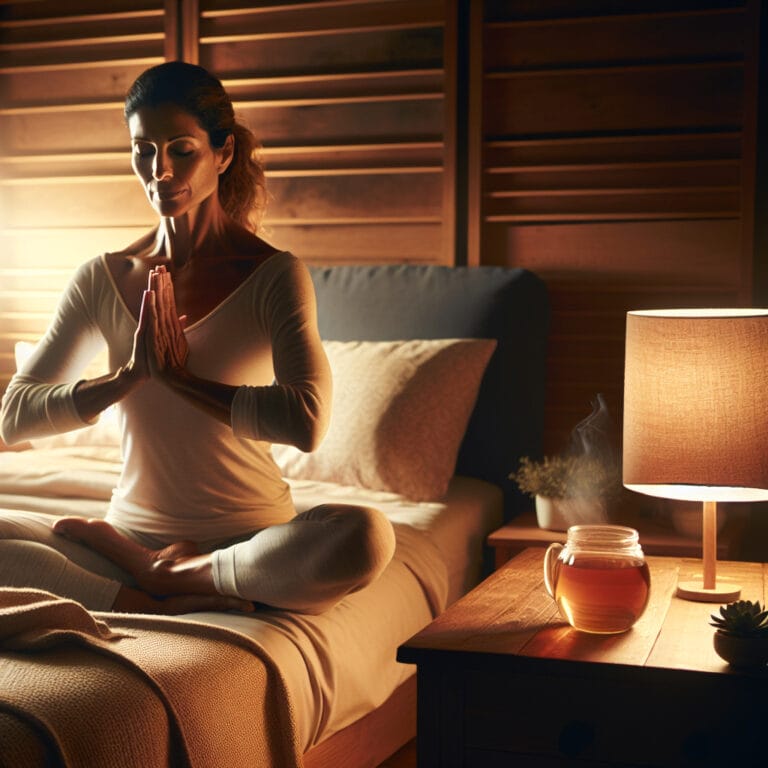
10 Effective Strategies for Creating a Sleep-Conducive Environment for Restful Nights
Table of Contents
- Introduction
- Strategy 1: Establish a Relaxing Pre-Sleep Routine
- Strategy 2: Optimize Bedroom Temperature
- Strategy 3: Invest in a Comfortable Mattress and Pillows
- Strategy 4: Reduce Noise Pollution
- Strategy 5: Use Appropriate Lighting
- Strategy 6: Limit Screen Time Before Bed
- Strategy 7: Aromatherapy and Sleep
- Strategy 8: Maintain a Clean and Organized Space
- Strategy 9: Consider the Role of Diet
- Strategy 10: Exercise Regularly
- Conclusion
- Frequently Asked Questions
Introduction
Understanding the intricate dance between our daily habits and the quality of rest we achieve, it’s paramount to foster a bedroom environment that serves as a sanctuary for slumber. Effective strategies for better sleep begin with temperature regulation; setting your thermostat to the sweet spot of around 65 degrees Fahrenheit can significantly improve sleep quality by aligning with your body’s natural drop in temperature. For hot sleepers, investing in cooling mattresses or breathable sheets can make all the difference in achieving that elusive state where you effortlessly fall asleep and stay asleep.
But there’s more to a sleep-conducive atmosphere than just a cool room. Light levels play a crucial role as well, impacting our circadian rhythm which dictates when we feel tired and awake. Blackout curtains or a simple sleep mask might just be the key to ensuring your room stays dark, signaling to your brain that it’s time for rest. Additionally, electronic devices emitting blue light should be banished from the bedroom at least an hour before bed, as they can disrupt our internal clock.
For those disturbed by urban clamor or household noises, white noise machines offer an ambient solution that masks unwanted sounds, helping you maintain uninterrupted slumber. Moreover, positioning yourself on a memory foam or hybrid mattress tailored to alleviate back pain ensures that your sleeping position contributes positively towards waking up feeling comfortable rather than stiff.
Above all else, promoting healthy sleep hygiene through these varied measures fosters an optimal environment where good night’s sleep is not left to chance but curated with intentionality—because when you’re sleeping well consistently, every facet of life seems just a little bit brighter.
Strategy 1: Establish a Relaxing Pre-Sleep Routine
Harnessing the power of an intentional sleep environment is key to transcending the woes of restless nights and transforming your bedroom into a bastion of tranquility. For those wrestling with back pain, a memory foam or hybrid mattress can work wonders by conforming to your sleeping position and providing targeted support. Meanwhile, hot sleepers may find relief with a cooling mattress and breathable sheets, ensuring temperature regulation that aligns with the optimal degrees Fahrenheit for slumber—around 65—to foster quality sleep.
Creating a room dark enough to signal your brain’s circadian rhythm towards shut-eye is another pivotal move; blackout curtains or a snug sleep mask can shield against intrusive light levels. And when it comes to electronic devices, banishing them from the bedroom is essential due to their pervasive blue light emissions, which can hinder one’s ability to fall asleep and stay asleep.
Amidst these effective strategies lies the foundation of sound sleep hygiene: promoting healthy sleep habits that shape every night into an opportunity for rejuvenation. Consider incorporating white noise machines if external sounds disrupt your peace or dabble in aromatherapy by using essential oils known for their calming properties. The aim is simple—a good night’s sleep where you’re sleeping deeply and waking up feeling comfortable each morning—and such deliberate steps are indispensable in etching out paths toward restful repose.
Strategy 2: Optimize Bedroom Temperature
For those eager to unlock the secrets to quality sleep, transitioning into a dream-filled slumber begins with perfecting the ambiance of your bedroom environment. A cooling mattress, paired with breathable sheets, caters impeccably to the hot sleeper, ensuring that both body temperature and room temperature are finely balanced within the ideal range—around 65 degrees Fahrenheit. This precise climate control is pivotal in fostering deeper, more restful states of slumber. A well-chosen memory foam or hybrid mattress not only supports your preferred sleeping position but aligns seamlessly with strategies designed to alleviate back pain and contribute significantly to overall sleep quality.
Moreover, mitigating distractions from blue light emitted by electronic devices and securing a room dark enough for sleep is crucial in maintaining one’s circadian rhythm. Utilizing blackout curtains or a fitted sleep mask can effectively shield against disruptive light levels, while white noise machines subtly drown out external noises that might otherwise fracture your sleep cycle. Infusing your sanctuary with essential oils may offer additional serenity through aromatherapy—an effective strategy for easing into a good night’s sleep. These elements coalesce beautifully within an optimized sleep hygiene regimen that promises not just fleeting moments of tranquility but sustained cycles where you’re sleeping soundly night after night.
Strategy 3: Invest in a Comfortable Mattress and Pillows
With the quest for a restorative slumber paramount in many minds, it is essential to understand that a mattress tailored to your sleeping position is not just an indulgence but a cornerstone of sleep hygiene. A memory foam mattress offers contours that cradle the natural alignment of your spine, while a hybrid mattress provides a balanced combination of support and cushioning—both are sound choices to mitigate back pain and enhance overall sleep quality. Beyond the foundation, pillows play an unsung hero’s role; whether you’re a side sleeper needing loftier support or someone who dozes on their back requiring something flatter, selecting the right pillow can mean the difference between waking up refreshed or with stiffness.
The bedroom environment should be meticulously curated with temperature regulation in mind; hot sleepers benefit from cooling mattresses and breathable sheets that work synergistically to maintain degrees Fahrenheit conducive to good night’s sleep. Room darkening solutions like blackout curtains complement this by ensuring light levels align with your circadian rhythm for uninterrupted rest. For those sensitive to noise interference, white noise machines offer an acoustic buffer, enveloping you in soothing sounds that help you fall asleep and stay asleep effortlessly.
Crafting these effective strategies into habit-forming rituals paves the way towards promoting healthy sleep habits—a fundamental practice where electronic devices emitting blue light are swapped out for calming essential oils as bedtime nears. The goal transcends merely feeling comfortable; it’s about reinforcing practices so integral they become second nature, allowing you to navigate seamlessly into tranquil nights where you’re sleeping peacefully time and again.
Strategy 4: Reduce Noise Pollution
Immersing yourself in a tranquil sleep environment, where whispers of serenity lull you into a deep slumber, requires more than just plush bedding—it’s an artful harmony of multiple elements working in concert. A cornerstone for achieving quality sleep is soundproofing your sanctuary, making it impervious to the cacophony of urban din or the abrupt interruptions from household noises. In this symphony for slumber, white noise machines serve as adept conductors—offering a consistent auditory backdrop that effectively masks disruptive sounds and fosters a room dark enough to signal ‘bedtime’ to your circadian rhythm.
For those who frequently find themselves counting sheep into the wee hours, incorporating strategies such as breathable sheets and cooling mattresses can be game-changers. These elements not only cater to hot sleepers but also promote temperature regulation vital for maintaining degrees Fahrenheit ideal for restorative rest—a meticulous balance on which your body’s own thermoregulation heavily relies.
Moreover, selecting the appropriate mattress—be it memory foam or hybrid—can cradle your sleeping position perfectly while mitigating back pain; whereas blackout curtains cast a veil over any encroaching light levels that may disrupt your journey through dreamland. Essential oils may waft you further along into good night’s sleep with their soothing aromas, complementing an environment optimized for when you’re sleeping.
Indeed, effective strategies for better sleep are a tapestry woven from various threads: the tactile comfort of mattresses attuned to your form; visual repose granted by darkness; olfactory pleasure provided by essential oils; auditory peace offered by white noise—all integral components fostering impeccable sleep hygiene and ensuring you stay asleep comfortably throughout each night.
Strategy 5: Use Appropriate Lighting
As we delve into the art of achieving quality sleep, it’s illuminating to recognize how light manipulation has a profound impact on our slumber. A well-curated sleep environment is critical for those yearning to quickly fall asleep and stay asleep throughout the night. Integrating blackout curtains in your bedroom environment can be revolutionary, as they create a room dark enough to ensure your circadian rhythm isn’t misled by external light levels, thereby enhancing your overall sleep quality. Coupling these with dimmer switches enables precise control over lighting—dimming lights an hour before bed helps signal to the body that it’s time to wind down.
Temperature regulation shouldn’t be overlooked either; for the hot sleeper, a cooling mattress paired with breathable sheets maintains a conducive degrees Fahrenheit for restful sleep. The memory foam mattress or hybrid mattress choices adapt gracefully to your sleeping position, providing support and easing back pain while you’re sleeping.
To further refine your sleep hygiene practices, consider minimizing blue light exposure from electronic devices as bedtime approaches—this will prevent potential disruptions in falling asleep. Should restlessness persist despite these strategies, adding white noise machines introduces soothing sounds that can mask ambient disturbances.
Finally, enveloping yourself in calming scents from essential oils might just be the sensory touch needed for ushering you into good nights’ sleep consistently. Through promoting healthy sleep habits like these within our daily routines, we craft an oasis that not only allows us to feel comfortable but also revolutionizes our relationship with rest itself.
Strategy 6: Limit Screen Time Before Bed
Navigating the terrain of quality sleep in our tech-saturated world necessitates strategic action against one of the most pervasive barriers to restful nights: blue light from electronic devices. Research reveals that this high-energy visible light can significantly impair melatonin production, a hormone instrumental in regulating our circadian rhythm. As we strive for effective strategies to enhance sleep quality, embracing a digital curfew stands as a cornerstone practice within any robust sleep hygiene regimen. By powering down smartphones, computers, and TVs well before bedtime, we shield ourselves from artificial light levels that can delay the onset of sleep and disrupt the natural cycle that guides us to fall asleep and stay asleep.
A bedroom environment cultivated with care increases the potency of such measures—think memory foam or hybrid mattresses aligning with your sleeping position for ultimate back pain relief and blackout curtains ensuring a room dark enough to maintain your body’s night-time mode. Hot sleepers will find solace in cooling mattresses teamed with breathable sheets for optimal degrees Fahrenheit, while white noise machines weave an auditory cocoon conducive for slumber.
In concert with these adjustments, introducing essential oils like lavender can elevate mood and relaxation—a sensory complement rounding out an ambient space designed not just for comfort but as a sanctuary where good nights’ sleep become routine chapters in life’s ledger. With temperature regulation on point and all senses accounted for, you’re poised to experience transformative rest—and it all starts by making peace with powering off.
Strategy 7: Aromatherapy and Sleep
Discovering the synergistic effect of essential oils within a sleep environment can be transformative for those seeking quality sleep. Lavender, with its calming properties, reigns supreme in the realm of sleep-promoting aromatherapy. Chamomile and bergamot also emerge as powerful allies, each contributing to a serene atmosphere conducive to relaxation. To harness the full potential of these natural essences, incorporate a few drops into a diffuser or apply them topically after diluting with a carrier oil—an effective strategy that ensures safety while maximizing benefits.
As part of your bedtime ritual, allow the diffuser to permeate your bedroom environment with soothing scents about 30 minutes before you plan to fall asleep. This subtle yet impactful practice not only elevates your room’s ambiance but also aligns with promoting healthy sleep habits that contribute significantly to sleeping comfortably through the night. The right balance of fragrance intensity is crucial; it should be noticeable enough to elicit relaxation without overwhelming the senses—a testament to meticulous temperature regulation and light levels management in crafting an ideal circadian rhythm-friendly space.
Embrace this aromatic dimension as part of a holistic approach where memory foam or hybrid mattresses cater to back pain relief, blackout curtains ensure room dark tranquility, and white noise machines weave an undisturbed auditory backdrop. With electronic devices switched off well in advance and blue light banished from your sleeping position’s vicinity, integrating essential oils completes an effective strategy mosaic for achieving good nights’ sleep within an impeccably curated bedroom environment—where you’re sleeping becomes synonymous with restorative repose.
Strategy 8: Maintain a Clean and Organized Space
Embarking on the journey to quality sleep often begins within the sanctity of a decluttered bedroom environment. Researchers find that a neat, organized space significantly lowers stress levels, paving the way for a tranquil mind more conducive to restful slumber. An effective strategy for those yearning for good nights’ sleep involves regular tidying sessions—designating homes for belongings and keeping surfaces free from disorder allows for an unburdened transition into sleep. The connection between cleanliness and relaxation is undeniable; as clutter dissipates, so too does the mental chaos that can interfere with our ability to fall asleep and stay asleep.
For hot sleepers, temperature regulation remains central; selecting breathable sheets and opting for a cooling mattress ensures degrees Fahrenheit are kept in check, aligning with your body’s natural propensity to cool down before bedtime. The addition of room-darkening blackout curtains or a comfortable sleep mask further nurtures one’s circadian rhythm by maintaining optimal light levels during nocturnal hours.
Incorporating white noise machines drowns out external disturbances that could disrupt your sleeping position’s serene state while memory foam or hybrid mattresses provide personalized support against back pain. Essential oils diffused gently throughout the room can enhance this temple of rest with their soothing scents—a nod towards cultivating a comprehensive sleep hygiene routine. As you declutter your space and mind, imbued strategies such as reducing blue light exposure from electronic devices contribute remarkably to establishing promoting healthy sleep habits where comfort becomes synonymous with nighttime repose.
Strategy 9: Consider the Role of Diet
Crafting a sleep-promoting diet is an often overlooked yet pivotal facet of any comprehensive sleep hygiene routine. Almonds and turkey, rich in the amino acid tryptophan, are nature’s lullabies that encourage the production of melatonin, guiding you effortlessly into a good night’s sleep. Similarly, warm milk and chamomile tea are not mere bedtime folklore; they contain elements that help relax muscles and soothe nerves, enabling you to fall asleep more quickly. On the other side of the dietary spectrum lies caffeine and spicy foods—culprits known for interrupting circadian rhythm due to their stimulant properties which can keep hot sleepers tossing well into prime sleeping hours.
For those struggling with back pain or seeking quality sleep untouched by bouts of wakefulness, it’s advisable to steer clear of heavy meals before bed. Such foods can cause discomfort and indigestion—a disruptive force against your quest for temperature regulation within your bedroom environment where degrees Fahrenheit matter deeply. Moreover, eschewing electronic devices laden with blue light in favor of a book or quiet meditation is an effective strategy ensuring light levels remain conducive to slumber.
In essence, nurturing promoting healthy sleep habits through mindful eating patterns alongside employing white noise machines or enveloping yourself under breathable sheets on either a memory foam mattress or hybrid mattress are holistic steps towards securing restorative rest where you’re sleeping peacefully becomes second nature. Combining these measures with darkness achieved by blackout curtains or a snugly fit sleep mask seals in your sanctuary against intrusions—whether from light pollution outside or internal disruptions from diet choices—granting you control over how comfortably you stay asleep throughout the night.
| Food/Dietary Element | Benefits | Drawbacks | Sleep Hygiene Tip |
|---|---|---|---|
| Almonds | Rich in tryptophan, encourage melatonin production | N/A | Consume as a light snack |
| Turkey | Rich in tryptophan, encourages melatonin production | N/A | Consume in moderate portions |
| Warm Milk | Relaxes muscles and soothes nerves | N/A | Drink before bedtime |
| Chamomile Tea | Relaxes muscles and soothes nerves | N/A | Drink as part of a bedtime routine |
| Caffeine | N/A | Interrupts circadian rhythm, keeps you awake | Avoid in the late afternoon and evening |
| Spicy Foods | N/A | Can cause indigestion and disrupt sleep | Avoid before bedtime |
| Heavy Meals | N/A | Can cause discomfort and indigestion | Avoid eating large meals close to bedtime |
| Electronic Devices | N/A | Blue light can inhibit melatonin production | Switch to reading or meditation before bed |
| White Noise Machines | Mask disruptive sounds | N/A | Use to create a consistent auditory backdrop |
| Breathable Sheets | Help maintain comfortable body temperature | N/A | Use on memory foam or hybrid mattresses |
| Blackout Curtains/Sleep Mask | Block out light pollution | N/A | Ensure bedroom is dark to aid sleep |
Strategy 10: Exercise Regularly
Embarking on a journey to exceptional sleep quality, it’s vital to recognize the profound influence of regular physical activity. Studies have consistently demonstrated that those who engage in moderate exercise report a significant boost in their ability to fall asleep and enjoy deeper rest. Yet, timing is crucial; engaging in vigorous workouts too close to bedtime can lead to increased heart rate and temperature—factors that might impede the descent into slumber. For optimal results, aim to wrap up any strenuous exercises at least three hours before you plan on hitting the sheets.
In cultivating your sleep environment for maximum benefit, consider how a cooling mattress can aid temperature regulation for hot sleepers or how blackout curtains ensure your room remains dark enough to support your circadian rhythm. A memory foam mattress or hybrid mattress caters superbly to various sleeping positions by alleviating back pain and ensuring you feel comfortable throughout the night. White noise machines weave an acoustic blanket that helps you stay asleep by muffling disturbing sounds.
A strategic approach involves limiting blue light exposure from electronic devices as evening falls, fostering an internal state conducive for rest. Pair this with breathable sheets and perhaps a dab of essential oils such as lavender—a sensory cue reinforcing bedtime readiness—and witness how these effective strategies harmonize within your bedroom environment, transforming good nights’ sleep from aspiration into nightly reality.
Conclusion
Crafting a sleep-conducive environment is paramount in the quest for quality sleep. To fall asleep swiftly and sustain restfulness, one must consider an array of effective strategies that harmonize with both our biological clock and personal comfort needs. Temperature regulation plays a critical role; hot sleepers should prioritize cooling mattresses and breathable sheets to maintain degrees Fahrenheit conducive to slumber. A memory foam mattress or hybrid mattress can profoundly impact those with back pain, offering tailored support to various sleeping positions and ensuring you feel comfortable throughout the night.
Creating a bedroom environment shielded from sensory disruptions is equally essential. Blackout curtains can keep your room dark, fortifying your circadian rhythm against intrusive light levels, while white noise machines offer an auditory refuge from external clamor, enabling you to stay asleep without interruption. Minimizing blue light exposure from electronic devices before bedtime aids natural melatonin production—vital for nodding off easily.
Incorporating essential oils like lavender into your sleep hygiene routine can enhance relaxation, ushering in good nights’ sleep through their calming scent profiles. All these components interlace within a meticulously curated space that not only invites rest but also reinforces promoting healthy sleep habits—where the moments when you’re sleeping are as rejuvenating as they are effortless. Adopt these changes and allow yourself to experience the profound transformation that comes with consistently restful nights.



